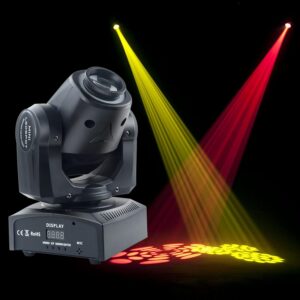Moving head lights are versatile and powerful stage lighting fixtures capable of creating dynamic and engaging effects. These lights are a staple in professional lighting design and are widely used in concerts, theaters, nightclubs, and various other entertainment venues. Their ability to move and rotate in multiple directions allows for unparalleled creativity and precision in illuminating spaces and enhancing performances.
Key Characteristics of
- Movement
- Moving head lights can perform pan (horizontal rotation) and tilt (vertical rotation) movements.
- Equipped with zoom capabilities, they can adjust the beam size to focus or spread light across specific areas. This versatility allows for precise lighting design tailored to the event.
- Types of Moving Head Lights
- Spotlights:
- Produce a sharp, focused beam of light, ideal for highlighting performers or objects.
- Often used for projecting gobos (patterns or logos).
- Wash Lights:
- Provide a wide and diffuse beam, creating smooth, even lighting across a larger area.
- Perfect for creating ambiance or illuminating entire stages.
- Beam Lights:
- Emit a narrow, intense beam of light, adding dramatic effects with sharp and concentrated visuals.
- Commonly used in concerts or high-energy events for bold light displays.
- Spotlights:
- Operation
- Controlled via DMX (Digital Multiplex), moving head lights can be connected to lighting consoles either through wired or wireless setups.
- Advanced programming allows for synchronized movements, color changes, and other intricate effects.
- Applications
- These fixtures are highly versatile and can be used to:
- Change colors dynamically to match the mood.
- Project gobos to display custom patterns or logos.
- Create dramatic lighting effects with synchronized movements.
- Often incorporated into performances to add energy, focus, and artistic flair.
- These fixtures are highly versatile and can be used to:
- Placement
- Rigging: Suspended from trusses or rigs for overhead effects.
- Podium Mounting: Positioned upright on stands for stable and precise projection.
- Floor Placement: Placed on the ground for uplighting or dramatic angles.
Tips for Using Moving Head Lights
- Event Type: Choose the right type of moving head light (spot, wash, or beam) based on the nature of the event.
- Programming: Invest time in programming sequences to create seamless lighting transitions and effects.
- Positioning: Optimize placement to avoid glare or shadows while maximizing the visual impact.
With their ability to transform a space through dynamic lighting, moving head lights are an indispensable tool for creating memorable events and performances.


